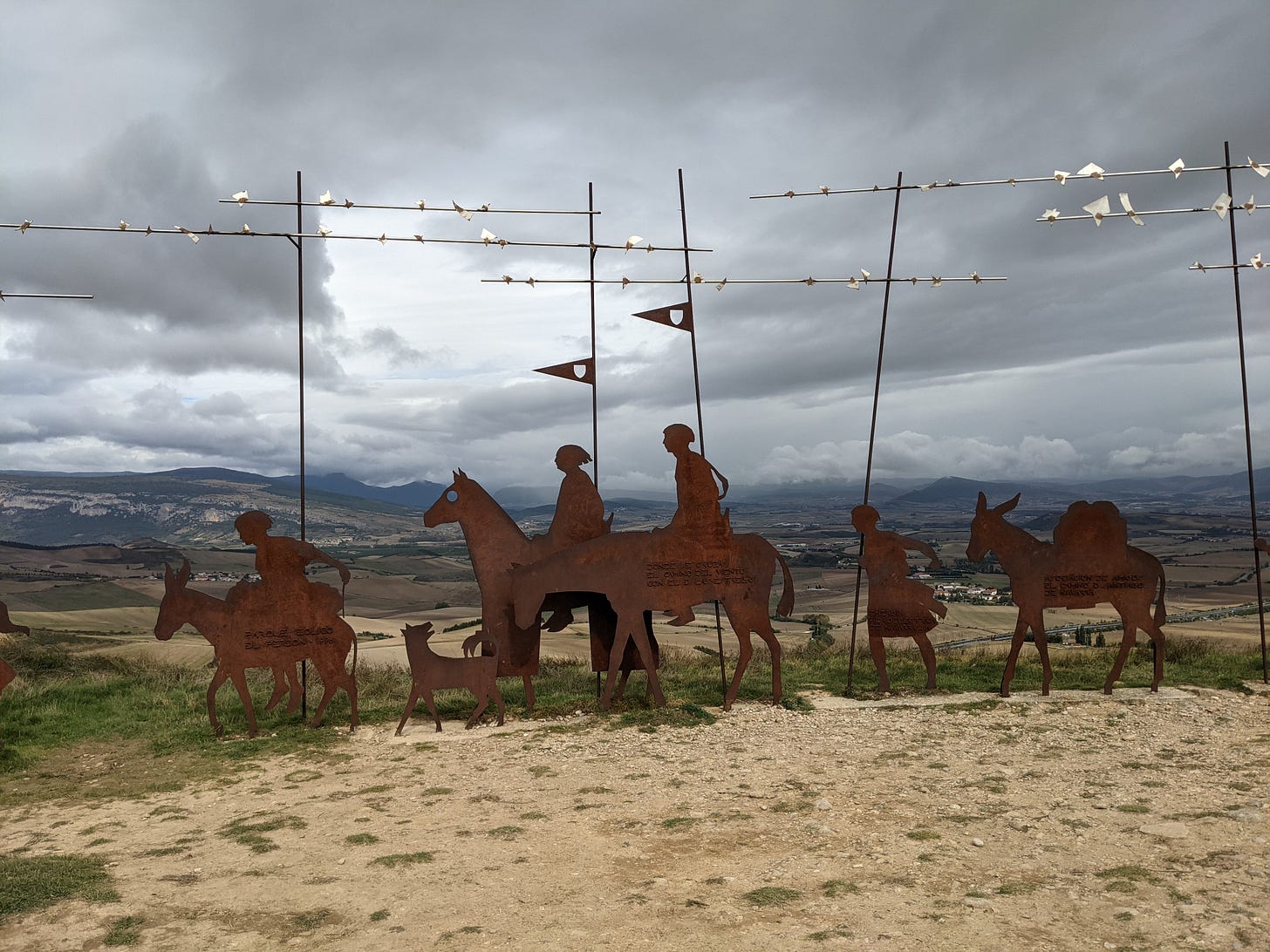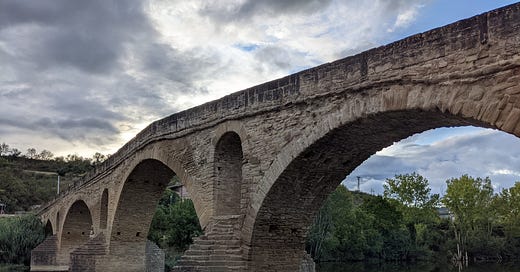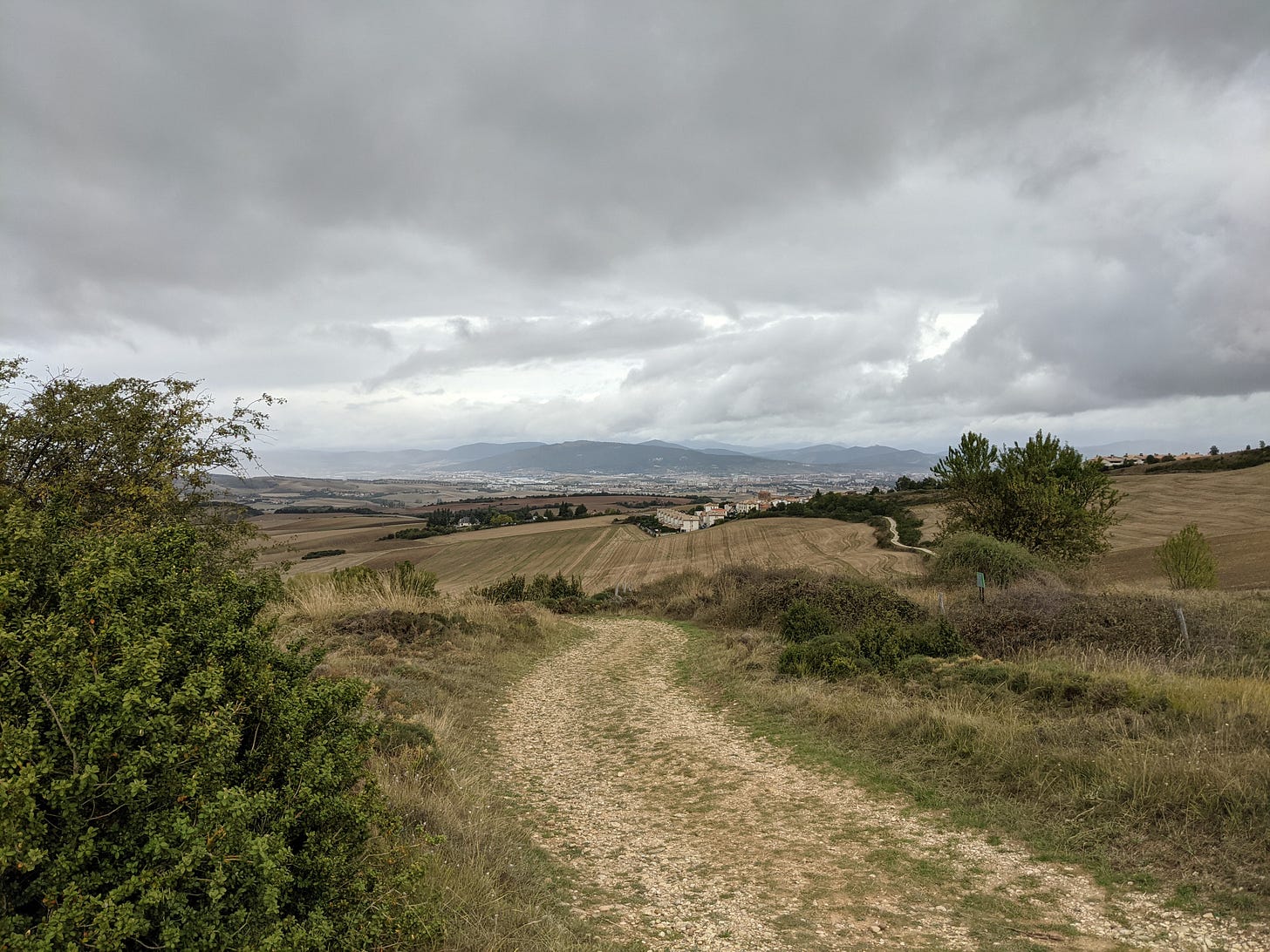Camino de Santiago Day 4: Pamplona to Puente la Reina
After come consideration I decide to leave Pamplona rather than spend another day there, as I could see myself just eating and drinking my way around the city again. The road goes on, and so must I
If you would like to follow me on my journey on the Camino de Santiago, then sign up now for free regular updates.
I consider staying an extra day in Pamplona – largely on the recommendation of others – but wait til morning to make my decision
The Camino is a moveable feast;
although the places you stop throughout the day or each night are just as important as the way that you move through them, by definition you can’t remain in any one place forever if you are to keep walking the way.
Though it is important to enjoy being in the place you are, the other side of the coin is that the movement through places is just as important as the places themselves;
Travel is equal parts moving and stopping, and each mode of being provides some of the fundamental meaning of the trip as a whole.
As I’ve learned from running through places without stopping, or in enjoying the beauty of the world from moving trains, there is a particular beauty in travelling for periods of time without stopping: it is the experience of enjoying a live concert versus a recorded album; to stop is to make a record;
to keep moving is experience life in the moment
You cannot get too attached to any one place on the Camino, big or small, village or city. Every day you must get up and move, and it is the movement towards the destination that is ultimately the key to the journey.
You could spend your whole life getting stuck in cities – I wonder how many pilgrims in times of yore made their way from St Jean with pious enthusiasm, before getting side-tracked in the taverns and carousing houses of Pamplona a few short days in, settling into the gutter, their journey continuing indefinitely for the rest of time
The artist in me would stop in every town or village indefinitely, to record in myself and on paper or conversation every infinitesimal detail that a place provides and presents you with, every single moment captured in an infinite number of ways – and cities provide a world of stimulation and meaning at every corner.
But to stop and record indefinitely is to give meaning to everything, and therefore nothing. There is only so much of our attention to give, and to give it to everything would keep us paralysed. We must move through the world, continue our Camino, to give our attention in fleeting portions and moments, and perhaps by the end, or when we return home – then we can reflect and see what has stuck with us.
For some things will, or many things, or only one, even if we only saw them in passing along the way.
I decide to leave.
The road out of Pamplona is pleasant, passing parks and a university campus. I buy some oranges from a suburban fruit shop.
I wonder what all these city people – walking to work or school, sitting in cafes, watching from windows – think of all these contented-looking pilgrims ambling through the city with their big backpacks. Do they ever feel like joining in and just walking out of town?
Leave the city, but don’t leave it too quickly either, though there’s some infuriating drilling and hammering going on that I need to get away from.
The landscape shifts again, to ploughed and yellowed fields.
Everyone’s talking about rain today, but it never comes. I think they worry too much.
I join the chain gang of pilgrims once I get out of the city, the first time since the Pyrenees where there is a tangible trail of people on the road, or at least that the landscape is open enough that you can see them snaking along up the trail.
The landscape shifts again, to ploughed and yellowed fields, tractors doing shuttles from one end to the other. Bushes of blackberries flank the rocky path that traverse the hill up towards a dominant line of wind turbines along the top of the range. Cars whizz along the distant motorway below; they don’t even know we’re up here, leading parallel lives.
In Zariquiegui I buy meat and cheese and bread and coffee from a corner shop which contains more food and tourist goods than a Tesco, eaten on the church wall as a growing body of familiar faces stream by, some stop, I’ve gotten to know some by now and am introduced to others.
Already I find myself referring to ‘we’ on the Camino, not ‘I’. Even when you meet people for the first time on Day 4, it feels like you’ve known them since Day 1, especially if their face is familiar.
The oranges I bought in Pamplona are outrageously good.
If you’re enjoying this and think others will enjoy reading about my journey on the Camino, then why not share it?
The rocky trail continues up to the Alto de Perdon, a famous photo-spot on the Camino. The place with the wind turbines. Police patrol at the top handing out business cards with their number – they say the descent towards Uterga causes such frequent injuries to pilgrims that they have a permanent patrol for call-outs – call us if you get into trouble. Everyone wants to take photos with the famous bronze sculptures of pilgrims, though I’m indifferent as I’d never heard of it before.
15km in, it's only when we begin our descent that Pamplona disappears and our attention opens up to the vast road ahead. We can see the day’s destination, a further 10km on in the valley: Puente la Reina.
The descent is steep, I’m mindful of my knee which has been stiff since my cycling trip through Ireland a few weeks ago. Already I’m seeing several knee braces on the legs of other walkers. I walk with Nathalie from Switzerland, Marissa from Puerto Rico, Kate from North Carolina and Carlos from Spain via England and back again. The slower pace of a walking in a group is preferable today; I don’t feel in any rush to get to where I’m going, and the conversation flows deeply as we walk and talk. Maybe now that we’re past Pamplona the road is opening us up a bit.
I stop for the evening in Puente la Reina, an historic point of convergence of several routes of the Camino, though as far as I’m concerned it’s got a cool bridge and beautiful narrow medieval streets, groups of familiar and unfamiliar pilgrims sitting outside its cafes and restaurants.
I’ve been sticking to the prescribed stages so far, averaging about 23/24km – which will take me to Santiago in 33 days, without any rest days, though I’ve given myself about 30 days in total to come here and complete the Camino. Maybe next week I’ll start upping the mileage, once my legs are broken in. They say it takes a week, or two, to get used to the routine of walking, and that rather than difficulty accruing, the physical challenges melt away as you progress, adapting to the road.
So they say.

A conversation with a friend yesterday:
If you rush to arrive in, say, Zubiri by 12:30 – you check in, shower, eat: that’s all. The old ladies arriving at 5, 6pm – they check in, shower, eat – there is no difference. You’re here to walk, so you may as well enjoy the walk, otherwise you just end up sitting around doing nothing.
Maybe I’m starting to take it into consideration
“Why are you doing the Camino?” I’d asked her
“Well, I like walking, so…”
To this day it is the most honest answer to that question I’ve heard from anyone.
In the alburgue room it’s just me and Ignacio, a gentleman from Sardinia of about 71. He’s been a familiar fixture on the road – no matter how fast I walk, when I stop for a lunch or a drink I turn around and see his happy head bobbing along, slow and steady, his eyes smiling from behind spectacles on his round face, and calves on him like Christmas hams, a reminder that the slow steady march of experience is a match for youthful fitness – perhaps even preferable over the course of the whole Camino.
He talks away in Italian to me, of which I know none. Older people everywhere just talk away in their own language, they don’t care if you don’t understand. In these situations I usually just talk back in English – explicit comprehension is not the point here, better to simply both relax and enjoy the confusion, and communicate in other ways, the shared amusement of the situation saying more than any words could.
Further down the road we would settle into a cordial routine where he would ask me with an enthusiastic smile, often with an effusive slap on the back, each time we met:
“Tutto bene?”
“Everything alright?”
He turns on the TV and there’s a report coming in about the volcano eruption in the Canary Islands. I don’t understand the Spanish newsreaders either, I just watch the footage of lava streaming down the mountain and through the towns and villages, nodding and smiling and saying “Yes” to everything he says.
“Tutto bene.”
If you’ve done the Camino, are thinking of doing it, or are just interested in discussing the Camino or travel in general - then please leave a comment. I’d love to hear from you.





